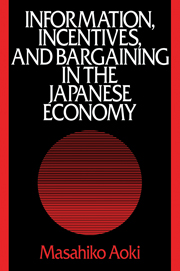 Information, Incentives and Bargaining in the Japanese Economy
Information, Incentives and Bargaining in the Japanese Economy Book contents
- Frontmatter
- Contents
- List of figures
- List of tables
- Preface
- 1 Introduction
- 2 The information structure of the J-firm
- 3 The ranking hierarchy of the J-firm as incentive scheme
- 4 Corporate finance, stockholding returns, and corporate governance structure
- 5 Bargaining game at the J-firm
- 6 The changing nature of industrial organization
- 7 Bureaupluralism
- 8 Culture and economic rationality
- Author index
- Subject index
3 - The ranking hierarchy of the J-firm as incentive scheme
Published online by Cambridge University Press: 14 January 2010
- Frontmatter
- Contents
- List of figures
- List of tables
- Preface
- 1 Introduction
- 2 The information structure of the J-firm
- 3 The ranking hierarchy of the J-firm as incentive scheme
- 4 Corporate finance, stockholding returns, and corporate governance structure
- 5 Bargaining game at the J-firm
- 6 The changing nature of industrial organization
- 7 Bureaupluralism
- 8 Culture and economic rationality
- Author index
- Subject index
Summary
In Chapter 2, I suggested that the internal efficiency of the J-firm, where it exists, may be largely due to the quality of the information structure institutionalized within it. That structure is characterized by rapid intrafirm communications, which are necessary for the coordinated adjustment of constituent operations in reaction to global (market) shocks as well as the decentralized handling of local shocks to minimize their impact on the system as a whole. Undoubtedly the quality of such an information system depends to a great extent on the information-processing capabilities (intellectual skills) of the workers who operate the system. I now turn to the problem of how such human resources can be accumulated and maintained within the firm. This is essentially a question of providing the employee of the J-firm with the incentive to develop the skills, knowledge, expertise, and cooperative attitude needed to effectively operate the horizontal informational structure.
This incentive problem has two aspects: the collective and the individual. The former provides appropriate incentives for firm-specific human resources as a whole, as distinguished from the firm's financial resources. I have already alluded to this aspect in Chapter 2 and will come back to it more fully in Chapter 5. This chapter deals with the latter aspect, that is, the way in which the J-firm provides its individual employees with an appropriate incentive package for competing in the development of skills, knowledge, and expertise useful to the firm, and for cooperating with one another when necessary.
- Type
- Chapter
- Information
- Information, Incentives and Bargaining in the Japanese EconomyA Microtheory of the Japanese Economy, pp. 49 - 98Publisher: Cambridge University PressPrint publication year: 1988


